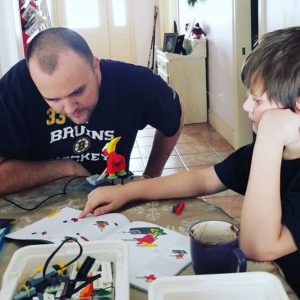Many parents wonder how best to organize their time when using Oak Meadow or other homeschooling curriculum. There is no one right way to approach homeschool planning, so go at it with an open mind! Try something that appeals to you, then fine-tune your process as you discover what works well for you and your children.
The Fundamentals for Getting Organized
 It can be helpful and calming for children and parents to have a predictable daily routine. Start by sketching out a typical week. When does your day begin? When do you and your children normally rise in the morning, eat meals, and tuck in at night? Do you have specific habits that help your children “get ready” when they wake up in the morning or wind down before bedtime? Time for meal preparation and cleanup is also important. Be sure to preserve space for these important daily rituals.
It can be helpful and calming for children and parents to have a predictable daily routine. Start by sketching out a typical week. When does your day begin? When do you and your children normally rise in the morning, eat meals, and tuck in at night? Do you have specific habits that help your children “get ready” when they wake up in the morning or wind down before bedtime? Time for meal preparation and cleanup is also important. Be sure to preserve space for these important daily rituals.
Perhaps you are already aware of a default rhythm as you and your children go about the day. If not, tune in for a few days and observe any patterns. When thinking about your schedule, consider the default rhythm that is already happening as well as any changes or habits that you’d like to foster. Remember that you can choose how firmly or loosely to adhere to your routine. Some children need by-the-clock structure to feel calm, safe, and centered. Some families need an element of flexibility in every single day to accommodate regular moving pieces or unknowns, but having a default schedule helps even very flexible families stay on track with their priorities.
Activities and Down Time
After you have mapped out the daily basics, think about your family’s outside commitments and how they fit into the week. Be sure to factor in travel and transition time before and after out-of-home activities. If an activity conflicts with the fundamentals already in place in your schedule, consider whether it would be best to shift the timing of a basic component on that one day, or in general across the entire week. You might find that as long as dinner happens within certain range of time each day, nobody complains. Or it may make sense to have dinner or naptime happen at the same time every day to cement the routine.
 Some scheduling adjustments are best avoided because the change upsets the family’s routine enough to cause more stress than the activity justifies. This can bring up challenging questions about priorities and how to best meet the needs of everyone in the family at once. Keep in mind that a great plan on paper is sometimes not a good fit in practice, and this may not become apparent until you’ve given it a try. Homeschool scheduling is an ever-shifting process. You’ll make adjustments along the way as you discover what each person in the family needs most.
Some scheduling adjustments are best avoided because the change upsets the family’s routine enough to cause more stress than the activity justifies. This can bring up challenging questions about priorities and how to best meet the needs of everyone in the family at once. Keep in mind that a great plan on paper is sometimes not a good fit in practice, and this may not become apparent until you’ve given it a try. Homeschool scheduling is an ever-shifting process. You’ll make adjustments along the way as you discover what each person in the family needs most.
Exercise, fresh air, and expansive time in nature help tremendously to balance the focused attention that is often needed for academics. Plan daily time for free play or other unstructured activities, ideally at the same time each day. Down time is also very important. Many families find that a daily mid-day period of quiet time helps both children and adults recharge and recenter themselves, so do your best to set aside time to make this a habit.
There are many possible ‘right’ ways to organize your homeschool day, week, month, and year. Your family’s schedule will reflect its uniqueness and individuality. With a solid approach to planning and scheduling, homeschooling doesn’t have to be overwhelming.
Planning
With household and family routines and the less flexible activities in place in your schedule (even tentatively), the next step is to make regular time for academic planning. Some parents prepare their academic plan monthly or even yearly, but it is important to revisit it regularly and to include your child in the process. Set aside a dedicated time each week to look over your homeschooling materials and curriculum and figure out what needs to be accomplished in the coming week. Set things up so that you feel as prepared as possible before the week begins.
 As children get older, consider sitting down with them once a week to look at the coming week’s plan and discuss what needs to happen and when. Sometimes our children have insights into their own habits and capabilities that will help ensure a successful plan. In time, students who are in the habit of a weekly planning session may be able to manage it on their own, or at least begin a to-do list themselves before finalizing it with a parent.
As children get older, consider sitting down with them once a week to look at the coming week’s plan and discuss what needs to happen and when. Sometimes our children have insights into their own habits and capabilities that will help ensure a successful plan. In time, students who are in the habit of a weekly planning session may be able to manage it on their own, or at least begin a to-do list themselves before finalizing it with a parent.
Visual tools can be very helpful. Some families create a weekly assignment sheet with checkboxes, so that each student can easily see what needs to be done and mark things off as they are completed. For others, a large chalkboard or whiteboard is the best tool for listing daily or weekly assignments, along with reminders of other important weekly responsibilities or events.
Preparing your schedule is like laying out a custom patchwork quilt. Continue moving the pieces around until they fit together just right. Over time you’ll hone and create a good flow for each day.
Academics
When the fundamentals are in place in your schedule, and you’ve included time for planning and outside activities, it’s time to work out in detail how academic time will be spent.
Identify regular times for focusing on academic learning and practice. It may take some trial and error to figure out how much time you need to block off for academics in each day or week. If you are unsure, start by reserving more time than you think you need, particularly if you’re still figuring out each family member’s inner rhythm.
In the younger grades (K-3), many families start their day with Circle Time. It is an opportunity for sharing a verse, poem, song, or story as a family. Some families also integrate yoga, dance, a thought question, or the cultivation of gratitude. Circle Time can be as long or as brief as your child can tolerate – just long enough to be a positive experience. If it’s not working well, change it!
For older children who have outgrown the concept of Circle Time, devise another way to connect each morning. Use that opportunity to discuss the plan for the day. This might be as simple as chatting over breakfast or checking in with each other en route to a scheduled morning activity. Make it a point to touch base with your child in some way each morning to go over the day’s plan and affirm your connection with each other.
Each Oak Meadow curriculum lesson is designed to be completed over the course of one week and contains an assignment summary in each subject, which can be used to create a checklist for each lesson. Some families choose to do something in every subject every day; other families prefer to use block scheduling, focusing exclusively on one or two subjects for a day or more at a time, or “loop scheduling,” where you attend to subjects one by one in a chosen order, returning to the top of the list once you’ve completed the loop. You can read more about these different approaches here. You might come up with another approach that will work even better for your child.
Consider how long your child can focus before he or she needs a break. Students and parents both benefit from the opportunity to switch gears when needed. Academics can be strategically woven around active play and down time to make learning time as efficient as possible.
One of the great joys of homeschooling is having the opportunity to follow a custom-fit schedule. There are many good possible ways to organize your homeschool time, so go ahead, make a plan, and give it a try. Do the best you can, allow for flexibility where needed, and trust in the process. You’ll soon figure out what works best for your family!